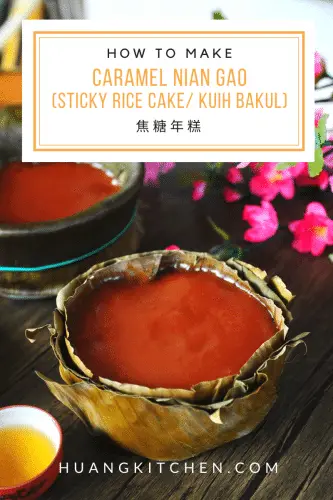This is an easy simplified recipe to make Caramel Nian Gao (年糕). This sweet delicacy is also known as Sticky Rice Cake, Kuih Bakul or Chinese New Year cake. Only simple ingredients needed and only 2 hours of steaming to enjoy this auspicious rice cake. This homemade Nian Gao is so delicious and perfect as gifts too. So let’s start cooking!
Watch How To Make Caramel Nian Gao (Sticky Rice Cake / Kuih Bakul) 焦糖年糕 – Recipe Video
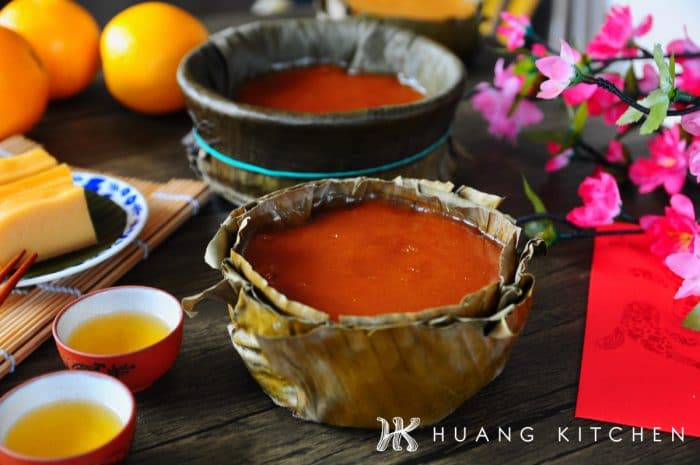
Let’s Learn How To Make Homemade Caramel Nian Gao With This Easy Recipe
Nian gao (年糕), also known as sticky rice cake or kuih bakul, is a popular rice cake usually served during the Chinese New Year. As its name is homonym to (年高) in Chinese, which means a Prosperous New Year, Nian Gao is most suitable and has become a MUST have delicacy for this auspicious celebration. It is also a popular gift to be given to friends and relatives for the Chinese New Year too.
And the good news is this simplified version of making Nian Gao is not at all difficult to make at home. What more is you only need simple ingredients and only 2 hours of steaming to enjoy this auspicious rice cake so let’s start cooking.
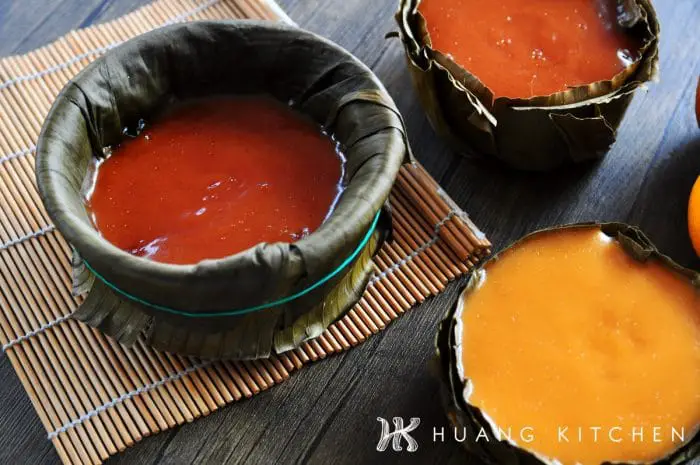
What is Nian Gao?
Nian Gao is sometimes known as Chinese New Year cake. It is a sweet delicacy prepared using glutinous rice flour and sugar. Although it can be eaten throughout the year, it is most popular and sort after during the Chinese New Year celebrations.
The traditional method of making Nian Gao is to soak glutinous rice and then blend into rice milk. Sugar is added, mix well and then poured into prepared moulds. It is then steamed for at least 12 hours before done. The long hours of steaming will caramelise the sugar and turn the Nian Gao into dark golden colour and can keep for a long time without turning mouldy. This method of making Nian Gao will also give the rice cake a firmer texture. However it is very time-consuming and labor-intensive.
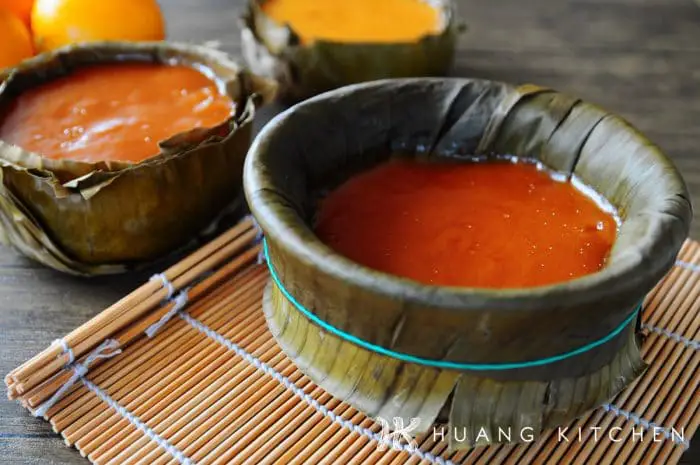
What is Caramel Nian Gao?
For this recipe (Caramel Nian Gao), it is a simplified version (not tedious at all) which will only take 2 hours of steaming and using incredibly simple ingredients namely glutinous rice flour and sugar. The trick is to caramelise the sugar first before adding into the glutinous rice flour. This will greatly shorten the steaming time of the Nian Gao.
However the rice cake made with glutinous rice flour is not as firm, but is soft and waxy. Also, because the steaming time is not long, the rice cake cannot be kept for too long. Keep the Nian Gao at room temperature for 3-5 days after they are made and then put them in the refrigerator.
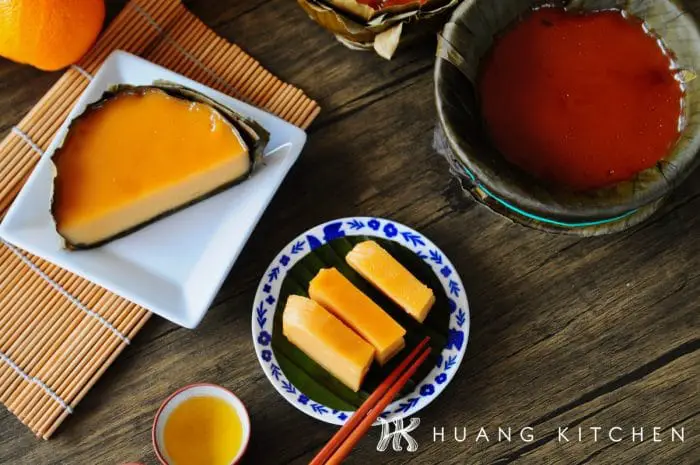
Ingredients Needed To Make Caramel Nian Gao
Ingredients:
- Glutinous Rice Flour
- Sugar
- Water, hot or warm
- Banana Leaves
- Pandan Leaves (optional)
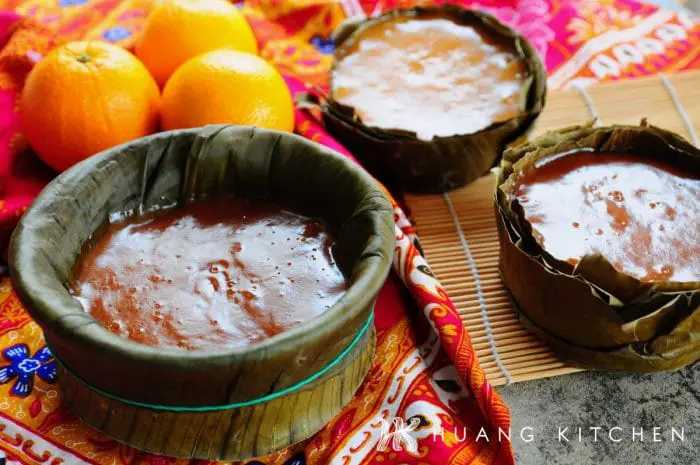
How to Make Caramel Nian Gao (A Summary)
Prepare The Moulds:
- Blanch banana leaves in hot water to soften them. Then clean with a damp cloth and cut into desired sizes to fit the moulds.
- Line each of the mould (3 times) with the softened banana leaves and secure with a rubber band.
Prepare Caramel (Golden Sugar Syrup):
- Boil water with pandan leaves added.
- Using medium-low heat, heat sugar till starts to melt. Add a bit of hot water and continue cooking till the sugar turns into a golden colour caramel. Off heat, add the remaining of the hot water slowly and bring the heat up and cooked till all caramel has melted.
- Set aside the caramel syrup to cool completely.
Prepare Nian Gao Batter:
Method 1: (Soft and waxy texture)
- Add in the caramelised sugar syrup into the glutinous rice flour slowly.
- Combine the syrup and the rice flour into a smooth batter with a spatula or a whisk.
- Strain the batter through a sieve to remove any possible lumps.
Method 2: (More chewy and firmer texture)
- Add in about half the cooled caramelised sugar (in batches) into the glutinous rice flour and knead into a smooth dough.
- Then pour in the balance half of the caramelised sugar and mix till a smooth and fluid batter remains.
- Strain the batter through a sieve to remove any possible lumps.
Steam Caramel Nian Gao:
- Pour the sieved batter equally into the prepared moulds.
- Cover the lined moulds with aluminium foil to prevent water from dripping into the batter.
- Steam in prepared steamer. First steam over medium high heat for 30 minutes. Then reduce to medium heat and continue to steam for another 1hr 30mins. (Refill hot water into steamer when necessary).
- After 2 hours of steaming, remove the aluminium foil cover and transfer Nian Gao from steamer to cool at room temperature till fully cooled before unmoulding.
Unmould Caramel Nian Gao:
- To unmould Nian Gao, loosen the banana leaves from mould and fold the leaves upwards. Then pull the rice cake out from the mould.
- Then cut off excess leaves on the top using a pair of scissors and the Nian Gao is good to go.
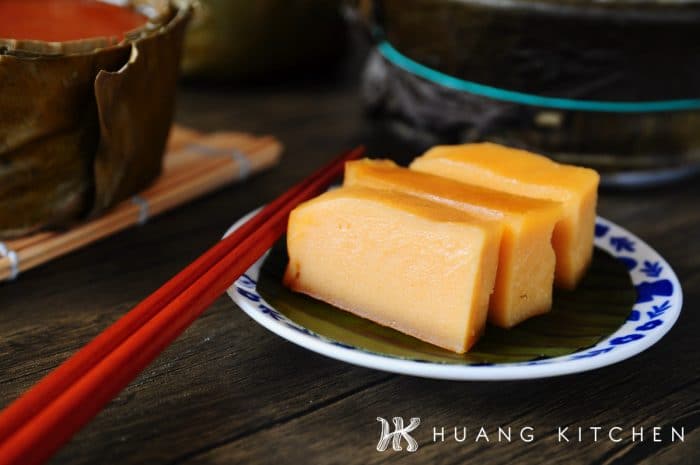
How To Serve Nian Gao?
There are many ways to serve Nian Gao. This Chinese delicacy is commonly eaten steamed or fried. It can be eaten on its own, steamed hot so that it is soft and sticky and or rolled in grated fresh coconut (See Steamed Nian Gao with Rolled Coconut Recipe). It can also be pan-fried with eggs and served immediately as a snack for afternoon tea. Nian Gao slices can be sandwiched between sweet potato or taro slices and fried in a golden batter (See Fried Nian Gao Sandwiches Recipe (Glutinous Rice Cake With Yam and Sweet Potato) 炸年糕三文治).
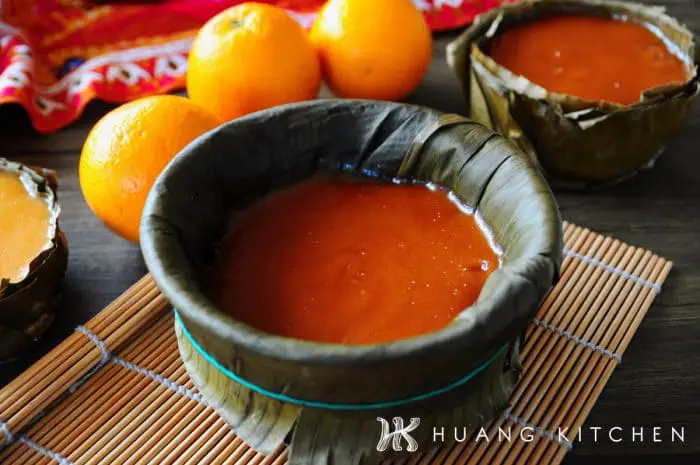
How To Store Homemade Caramel Nian Gao?
Wrap the Nian Gao up with plastic wrapper or put in airtight container and they will be ready in 2 days. On the third day, the nian gao will be much more firm and can be sliced. After day 3, keep Nian Gao refrigerated for storage. Wrap them up and keep them in the refrigerator or they will start to get mouldy as there is no preservatives and the steaming time has been greatly reduced.
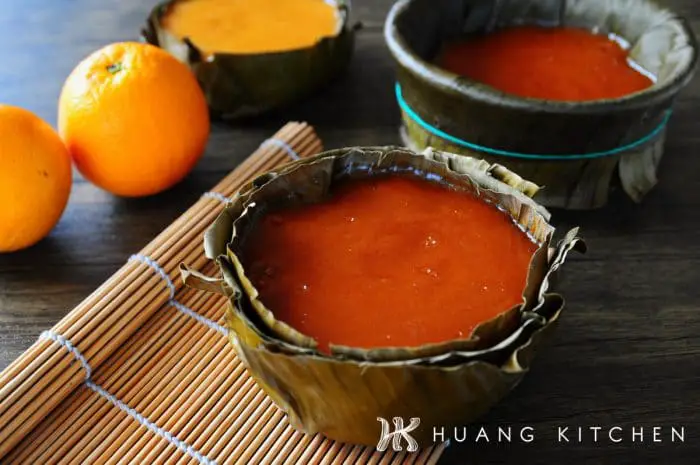
Important Recipe Tips To Make Caramel Nian Gao
For Preparing Moulds,
- The moulds can be store bought or substituted with any clean metal cans or ramekins. It is important to cover the entire inner surface with banana leaves to avoid the glutinous rice flour batter from leaking out during steaming. Use at least two layers of banana leaves to line moulds to ensure that there would be no leakage. Using banana leaves to line moulds will also infuse its aroma and flavour into the Nian Gao. If banana leaves are not available, you can line the moulds with non-stick baking paper or parchment paper. However, nian gao will lack the natural aroma of the banana leaves.
For Preparing Caramel,
- Do not over stir and do not cook until dark brown in colour or the nian gao will taste bitter. Use a thicker base cooking pot to cook the caramel so as to reduce the chance of burning. Add the hot water gently and do not add too much initially as the sugar will react with the water and boil rapidly. You may use less sugar for a less sweet version. But, since sugar is a natural preservative, the nian gao made with less sugar content will get mouldy faster than those that are sweeter. Therefore it is advisable to store the nian gao with less sugar in the refrigerator after a few days at room temperature.
For Preparing Glutinous Rice Batter,
- There are 2 methods to make the batter. Method 1 is just to slowly add in the caramel syrup into glutinous rice flour and stir into a smooth batter. This method yield rice cake that is soft and waxy. Method 2 uses about half the syrup to knead the glutinous rice flour into a smooth dough. Then the balance of the caramel syrup is poured into the dough and mix to form a smooth and fluid batter again. This method gives the Nian Gao a firmer and more chewy texture.
For Steaming Nian Gao,
- Check the level of water in the steamer from time to time to ensure there is enough water for steaming at all times as the steaming time is 2 hours. The colour of Nian Gao will turn darker when fully cooked and at room temperature.
For Serving Nian Gao,
- Freshly made Nian Gao is very soft. It is easier to cut into slices after refrigeration for two days, as it will become firmer after refrigeration.
For Storing Nian Gao,
- The simplified way of making it takes much less time and, therefore, needs to be refrigerated as it can get mouldy quickly at room temperature. Keep at room temperature for maximum of 2 days. Then wrap them up and keep them refrigerated.
Other Nian Gao Recipes You May Like:
- Fried Nian Gao Sandwiches (Glutinous Rice Cake Fritters With Yam and Sweet Potato) 炸年糕芋头木薯三文治
- Steamed Nian Gao with Coconut 椰丝蒸年糕
- Fried Nian Gao Sesame Balls (Kuih Bakul Jian Dui) 炸年糕芝麻球
- Pan Fried Nian Gao with Egg 煎年糕
Caramel Nian Gao (Sticky Rice Cake / Kuih Bakul) 焦糖年糕
Tap or Hover to Adjust Servings
Equipment
- 2 cake mould 12 inch diameter, 7 inch height
Ingredients
Ingredients:
- 400 grams glutinous rice flour, sifted
- 380 grams sugar
- 500 grams water, warm to hot water
- 3 stalks pandan leaves
- 2 banana leaves, blanched
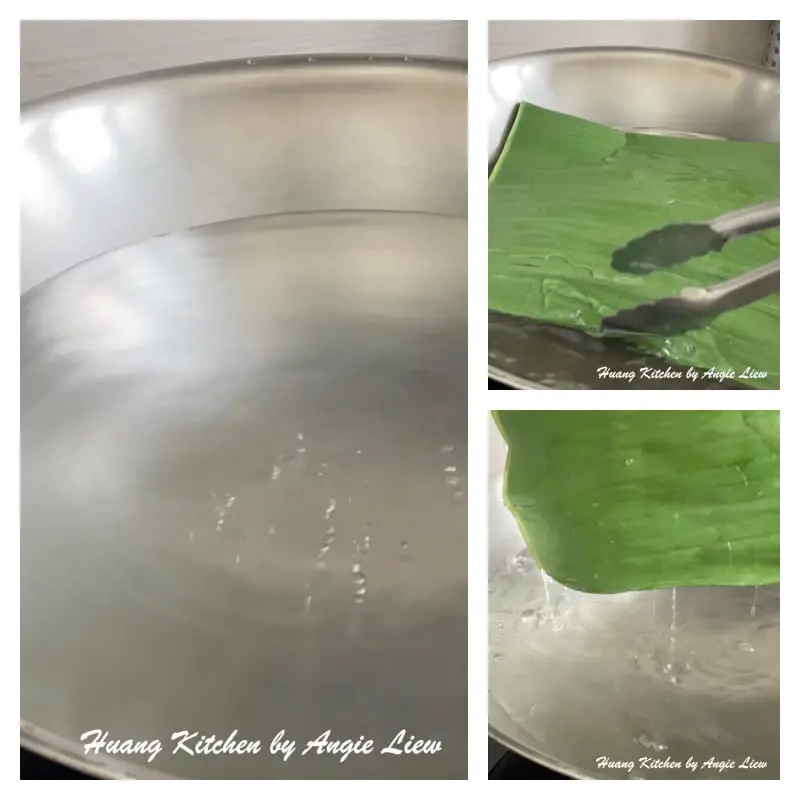 Blanch banana leaves in hot or boiling water to soften the leaves. This will prevent the leaves to break easily when used to wrap around the moulds.
Blanch banana leaves in hot or boiling water to soften the leaves. This will prevent the leaves to break easily when used to wrap around the moulds.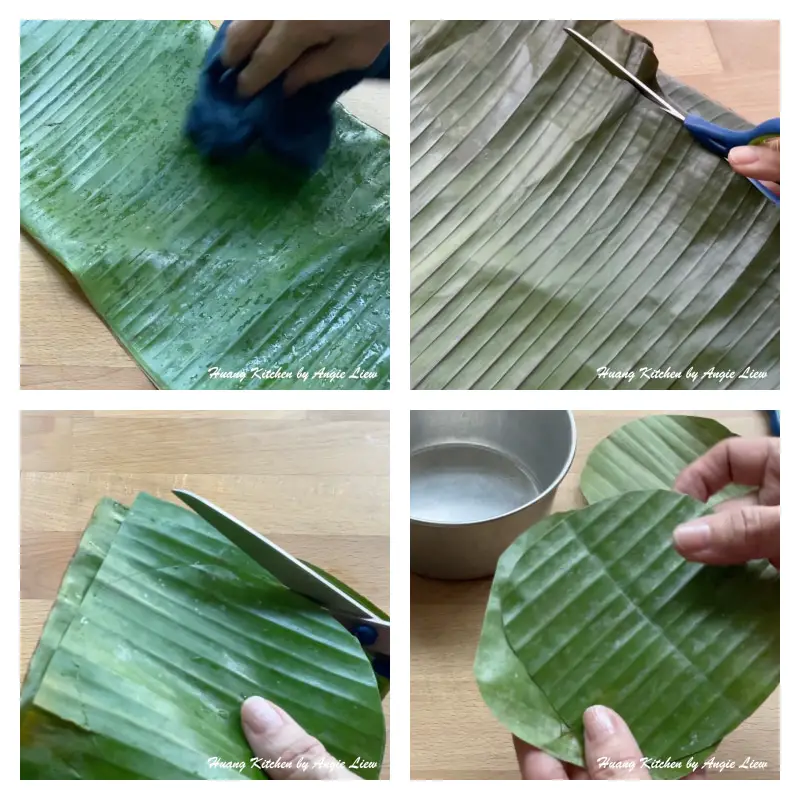 Clean and dry the softened leaves gently with a damp cloth. Then cut out the banana leaves into the desired length, cut pieces of round shaped leaves with the diameter slightly bigger than the base of mould using a pair of scissors.
Clean and dry the softened leaves gently with a damp cloth. Then cut out the banana leaves into the desired length, cut pieces of round shaped leaves with the diameter slightly bigger than the base of mould using a pair of scissors.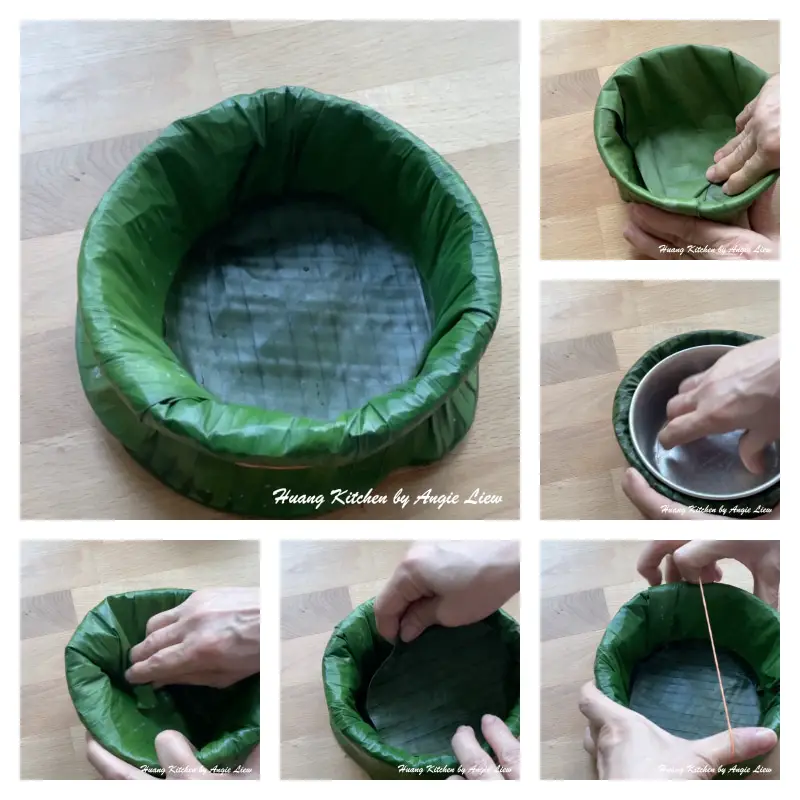 Wrap the banana leaves around the outer rim of the mould and insert the remaining part of the leaves into the mould. Insert a smaller round container into the mould and press the leaves against the base and the inner wall of the mould. Repeat to wrap the mould another 2 layers. Then insert the round shaped leaves and press against the bottom to cover the base completely. Finally secure by tying a rubber band around the rim of the mould.
Wrap the banana leaves around the outer rim of the mould and insert the remaining part of the leaves into the mould. Insert a smaller round container into the mould and press the leaves against the base and the inner wall of the mould. Repeat to wrap the mould another 2 layers. Then insert the round shaped leaves and press against the bottom to cover the base completely. Finally secure by tying a rubber band around the rim of the mould.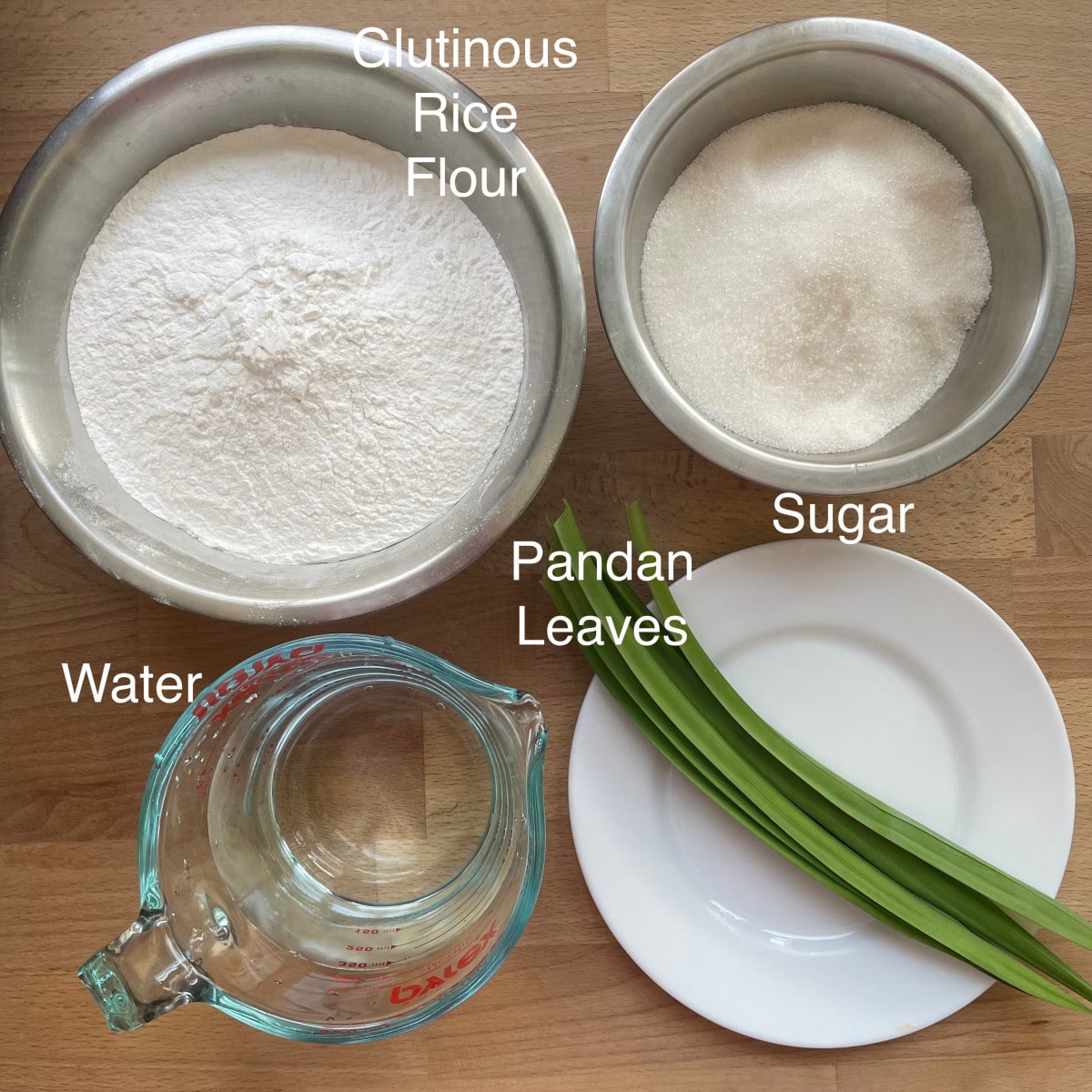 Have ready ingredients to make the golden sugar syrup (caramel) and glutinous rice batter.
Have ready ingredients to make the golden sugar syrup (caramel) and glutinous rice batter.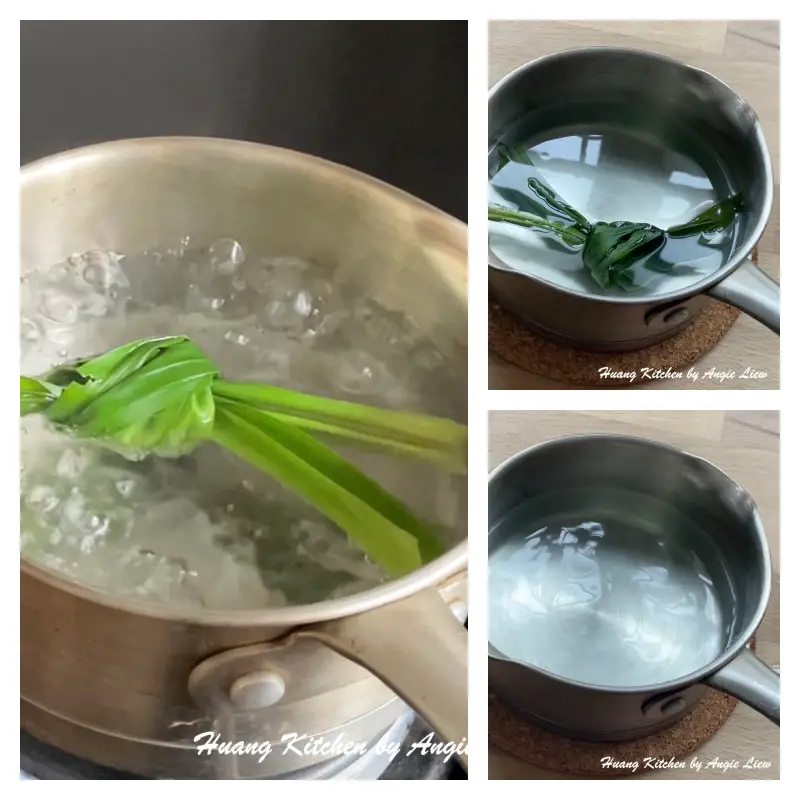 First boil water with pandan leaves added. Let the pandan leaves steep in the hot water for about 10 minutes for extra fragrance.
First boil water with pandan leaves added. Let the pandan leaves steep in the hot water for about 10 minutes for extra fragrance.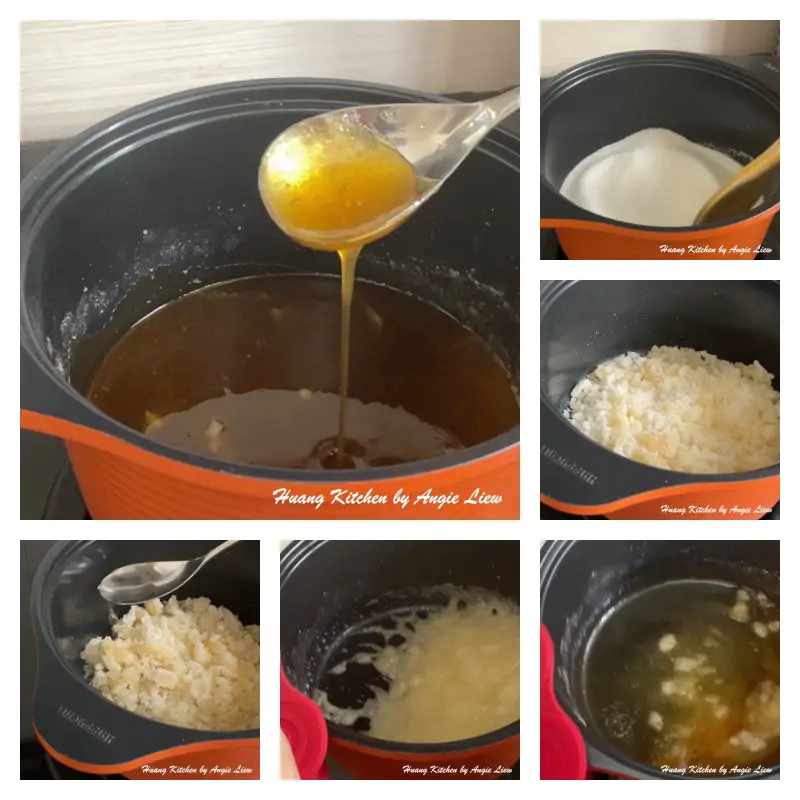 Heat sugar in a pot over medium-low heat until starts to melt. Gently add in a bit of hot water by the edge of the pot. Continue cooking until you have a golden colour caramel. Do not stir the sugar too much. Tilt the pot around to make sure the sugar caramelised evenly.
Heat sugar in a pot over medium-low heat until starts to melt. Gently add in a bit of hot water by the edge of the pot. Continue cooking until you have a golden colour caramel. Do not stir the sugar too much. Tilt the pot around to make sure the sugar caramelised evenly.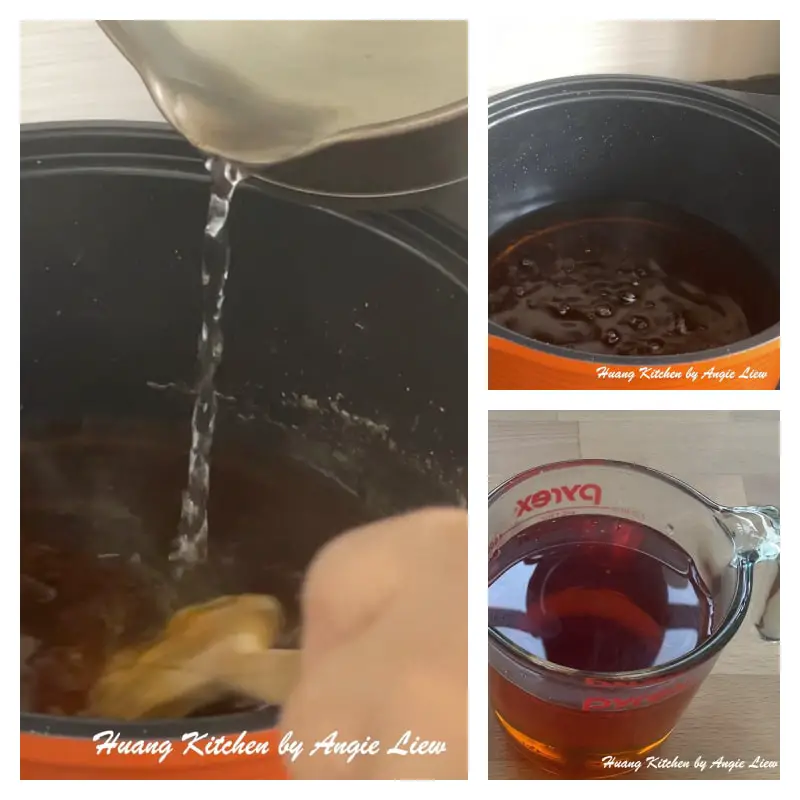 When sugar has caramelised, off the heat and slowly add in the remaining hot water. Then heat up again until all caramel has completely melted. Leave the golden caramel syrup to cool completely before use.
When sugar has caramelised, off the heat and slowly add in the remaining hot water. Then heat up again until all caramel has completely melted. Leave the golden caramel syrup to cool completely before use.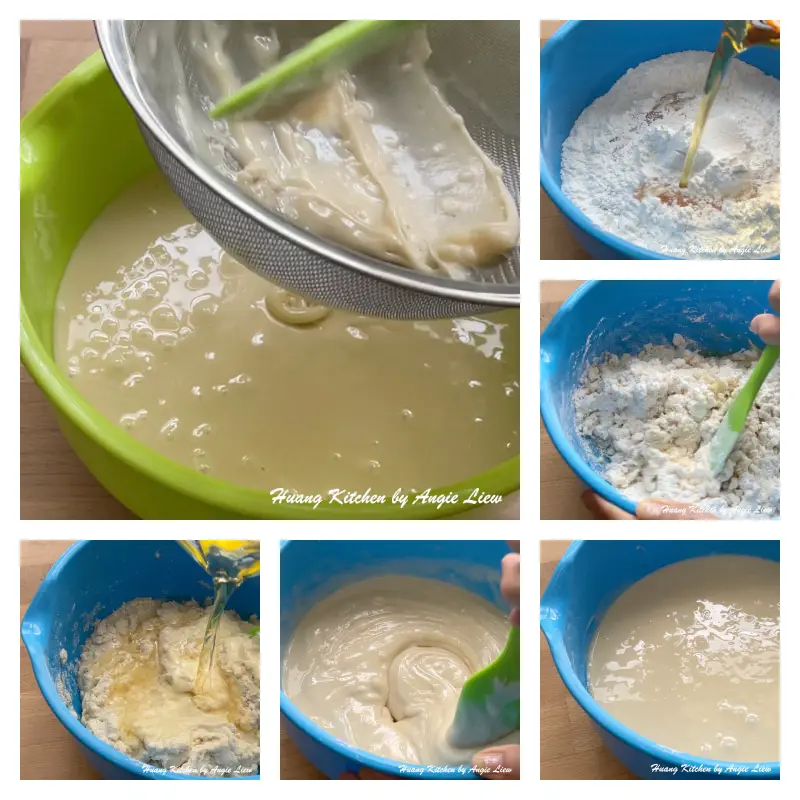 Place the sifted glutinous rice flour into a large mixing bowl. Then in stages, slowly add in the caramelised sugar syrup. Using a spatula, mix and combine the syrup and glutinous rice flour into a smooth batter. Strain the batter to remove any possible lumps.
Place the sifted glutinous rice flour into a large mixing bowl. Then in stages, slowly add in the caramelised sugar syrup. Using a spatula, mix and combine the syrup and glutinous rice flour into a smooth batter. Strain the batter to remove any possible lumps.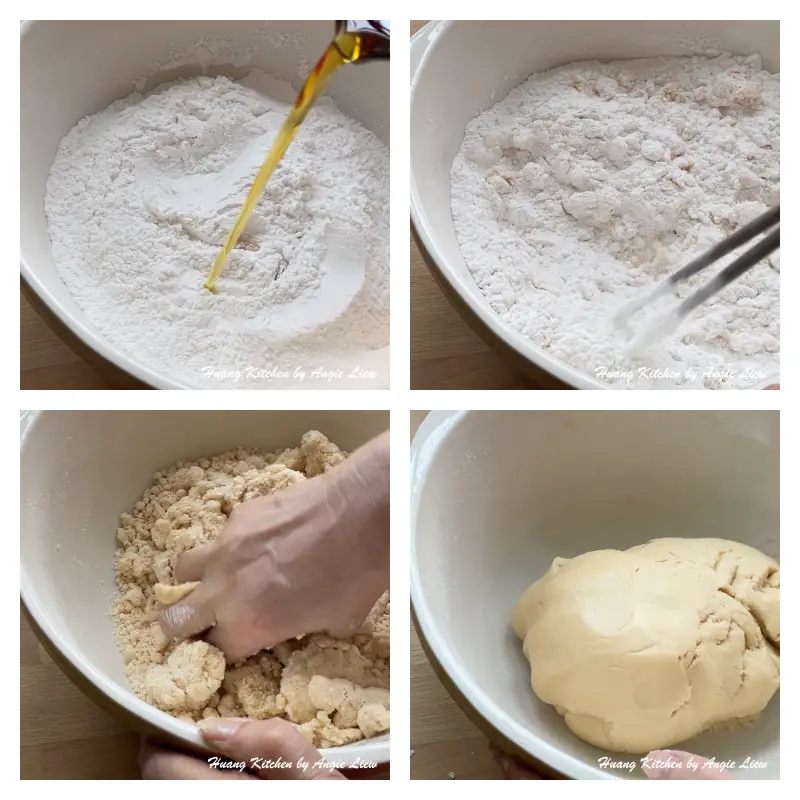 Place the sifted glutinous rice flour into a large mixing bowl. Then add in about half the cooled sugar syrup and mix together with a whisk or a pair of chopsticks. Then using your hand, knead the mixture into a smooth dough.
Place the sifted glutinous rice flour into a large mixing bowl. Then add in about half the cooled sugar syrup and mix together with a whisk or a pair of chopsticks. Then using your hand, knead the mixture into a smooth dough.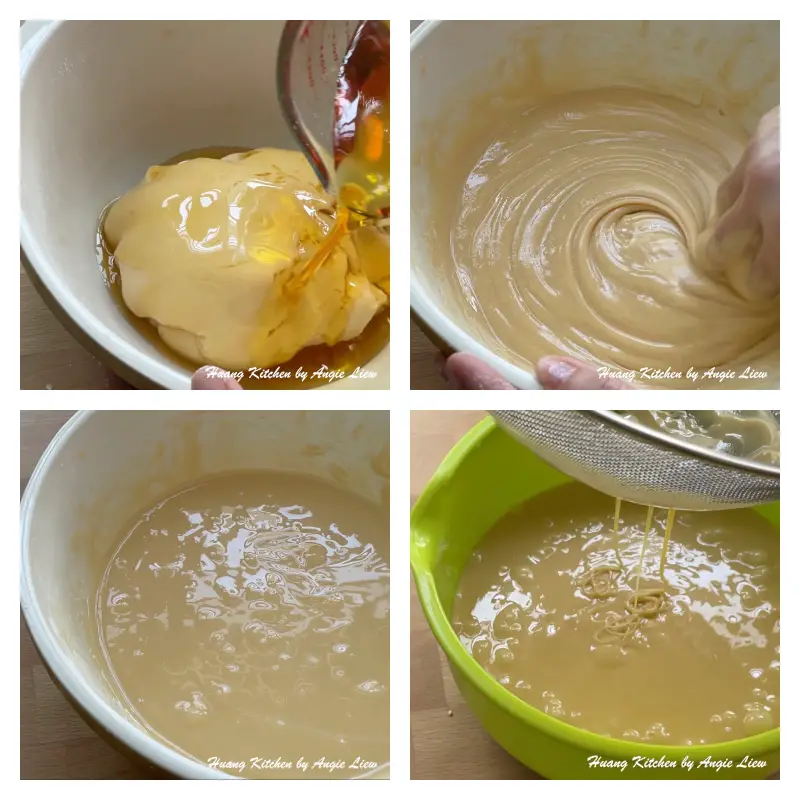 Then add in the remaining sugar syrup into the dough, in stages. Continue to knead the dough till it becomes a fluid batter again. Then strain the batter to remove any possible lumps and to ensure a smooth batter.
Then add in the remaining sugar syrup into the dough, in stages. Continue to knead the dough till it becomes a fluid batter again. Then strain the batter to remove any possible lumps and to ensure a smooth batter.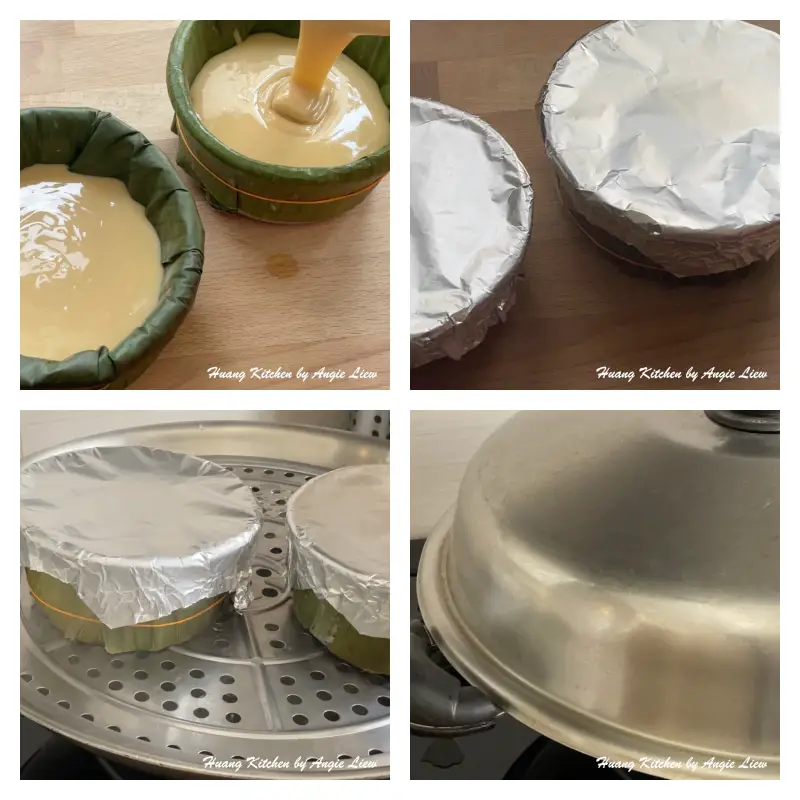 Pour the sieved batter into the banana leaves lined moulds. Cover with aluminium foil (to prevent water dripping into the batter). Place into prepared steamer to steam. Steam the Nian Gao over medium high heat for 30 minutes. Then reduce to medium heat and continue steaming for another 1hr 30 minutes. Refill hot water into steamer when needed.
Pour the sieved batter into the banana leaves lined moulds. Cover with aluminium foil (to prevent water dripping into the batter). Place into prepared steamer to steam. Steam the Nian Gao over medium high heat for 30 minutes. Then reduce to medium heat and continue steaming for another 1hr 30 minutes. Refill hot water into steamer when needed.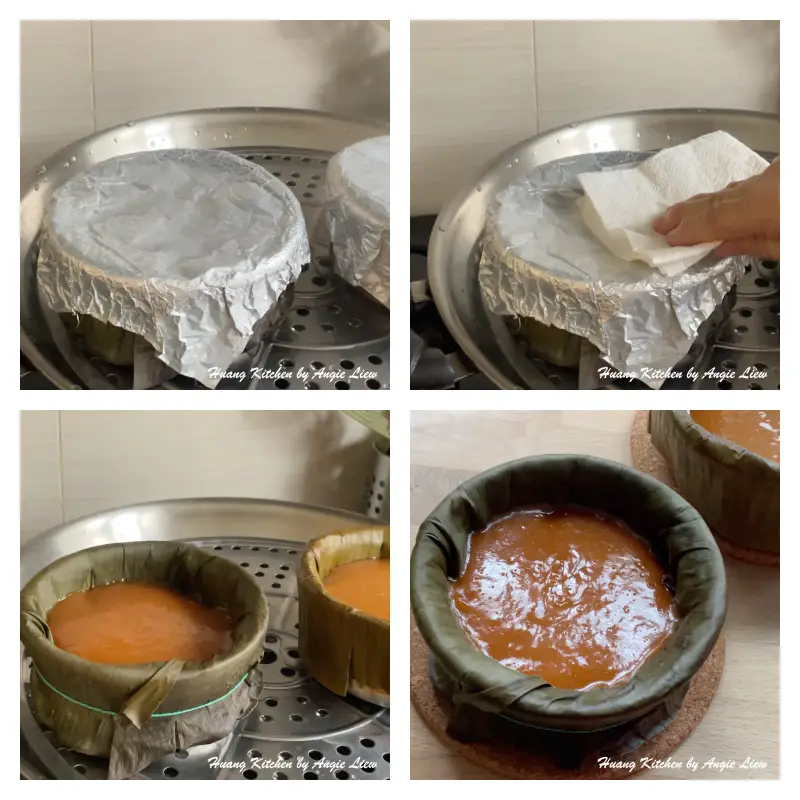 After 2 hours of steaming, it is done. Pat dry excess water on the top and remove the aluminium foil covering the nian gao. Remove from steamer and let it cool at room temperature. Be sure it is fully cooled before unmoulding. It is normal practise to unmould them on the next day.
After 2 hours of steaming, it is done. Pat dry excess water on the top and remove the aluminium foil covering the nian gao. Remove from steamer and let it cool at room temperature. Be sure it is fully cooled before unmoulding. It is normal practise to unmould them on the next day.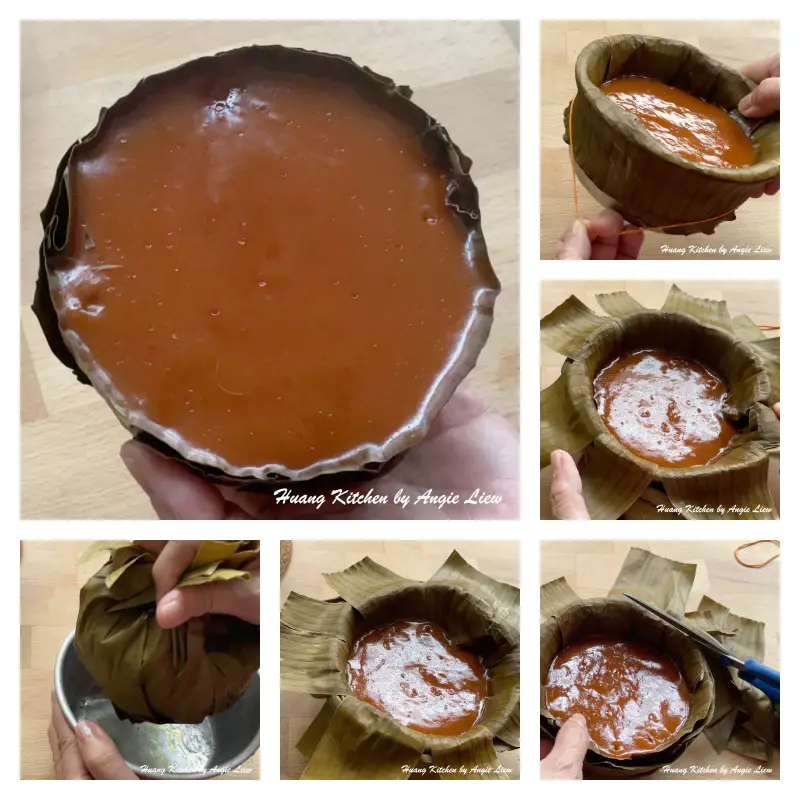 To unmold the nian gao, first remove the rubber band and loosen the banana leaves around the mould. Fold the leaves upwards, then pull the nian gao out from the mould. Finally trim off excess leaves on the top using scissors and we are done!
To unmold the nian gao, first remove the rubber band and loosen the banana leaves around the mould. Fold the leaves upwards, then pull the nian gao out from the mould. Finally trim off excess leaves on the top using scissors and we are done!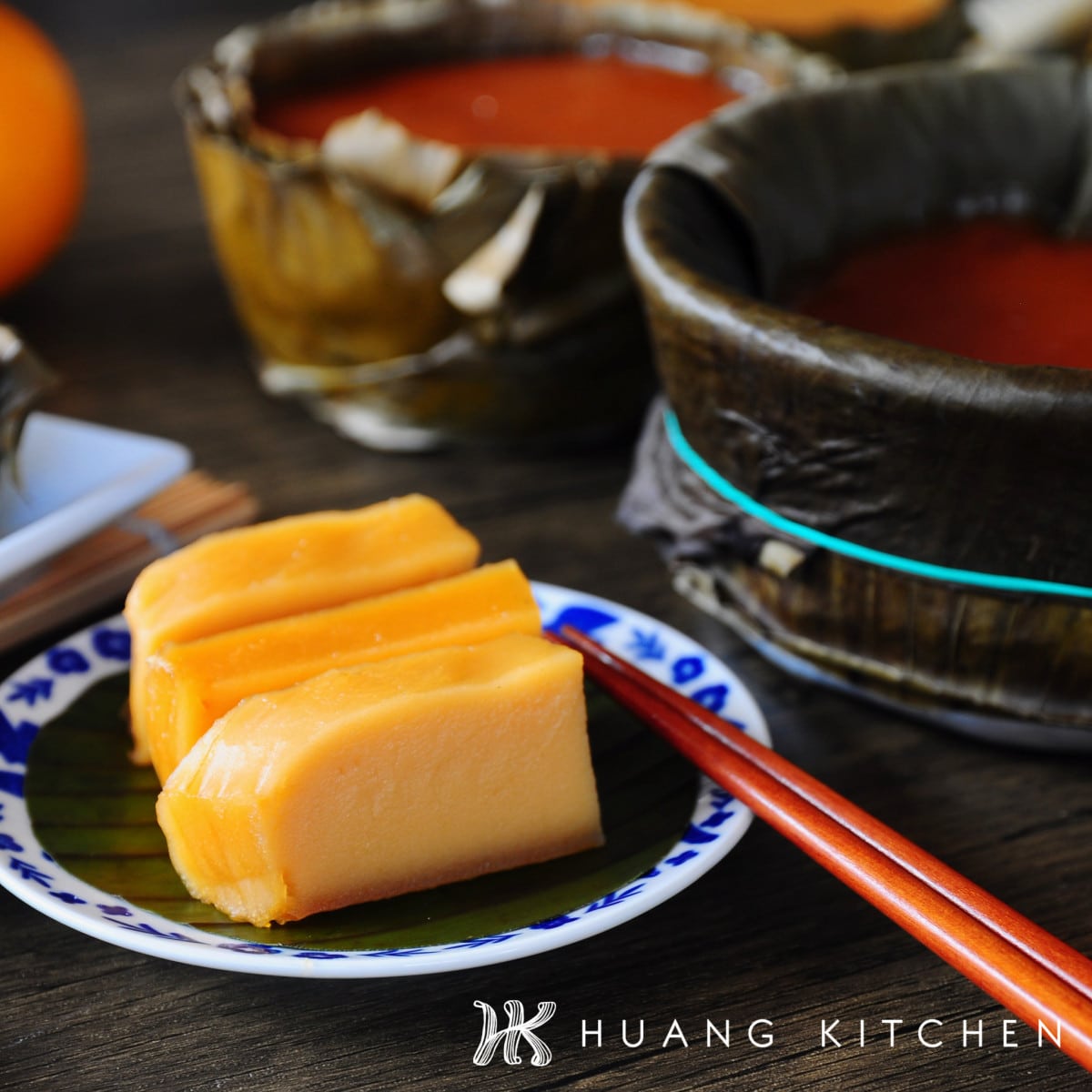 Freshly made Nian Gao is very soft. It is easier to cut into slices after refrigeration for two days, as it will become firmer after refrigeration. As always, Enjoy!
Freshly made Nian Gao is very soft. It is easier to cut into slices after refrigeration for two days, as it will become firmer after refrigeration. As always, Enjoy!
Instructions
Preparing the moulds:
Preparing Caramel:
Preparing Nian Gao Batter: (Method 1)
Preparing Nian Gao Batter: (Method 2)
Steaming Caramel Nian Gao:
Unmoulding Nian Gao:
To serve:
Enjoy!
Recipe Video
Notes
- It is important to cover the entire inner surface with banana leaves to avoid the glutinous rice flour mixture from leaking out during steaming. Also to line at least 2 layers of banana leaves. Since glutinous rice flour is very sticky, it can be challenging to remove the nian gao from the container if it sticks onto the can.
- lining the moulds with multi-layers of banana leaves will also infuse the banana leaves aroma and flavor into the nian gao.
- If banana leaves is not available, you can line the moulds with non-stick baking paper or parchment paper. However, nian gao will lack the natural aroma of the banana leaves.
- do not over stir and do not cook until dark brown in colour or the nian gao will taste bitter.
- Use a thicker base cooking pot to cook the caramel so as to reduce the chance of burning.
- Add the hot water gently and do not add too much initially as the sugar will react with the water and boil rapidly.
- You may use less sugar for a less sweet version. But, since sugar is a natural preservative, the nian gao made with less sugar content will get mouldy faster than those that are sweeter. Therefore it is advisable to store the nian gao with less sugar in the refrigerator after a few days at room temperature.
- Method 1 – slowly add in the caramel syrup into glutinous rice flour and stir into a smooth batter. This method yield rice cake that is soft and waxy.
- Method 2 – add about half the syrup into glutinous rice flour and knead into a smooth dough. Then the balance of the caramel syrup is added into the dough and mix to form a smooth and fluid batter again. This method gives the Nian Gao a firmer and chewy texture.
- Since it takes two hours to steam the nian gao, check the level of water in the steamer from time to time to ensure there is enough water for steaming at all times.
- The colour of Nian Gao will turn darker when fully cooked and and at room temperature.
- The simplified way of making Nian Gao takes much less time and therefore needs to be refrigerated as it can get mouldy quickly at room temperature and no preservatives added.




